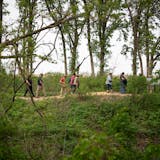Minnesota has gone all-in on contact tracing — mobilizing more than 400 interviewers and investigators to find people at risk for COVID-19 and prevent them from spreading the infectious disease.
But a new report questions that strategy against the coronavirus causing this pandemic. And those concerns were raised irrespective of the mass protests over the death of George Floyd, which could produce a new wave of COVID-19 cases that would be tough to trace.
"We've almost seen a mind-set that if a little contact tracing is good, a lot more must be better. … We're saying, 'No that's not true,' " Michael Osterholm, executive director of the University of Minnesota's Center for Infectious Disease Research and Policy (CIDRAP), said on Tuesday.
CIDRAP's report stated that contact tracing is valuable against viruses that infect a small percentage of a community, and cause clear symptoms, but that COVID-19 is widespread and involves a coronavirus that many people carry without symptoms.
The report recommends continued study to see if contact tracing works in the U.S. rather than assuming that it will work as well as it did in Asian countries with strict government testing mandates and quarantines.
Testing boosts tracing
The Minnesota Department of Health on Tuesday reported 25,508 lab-confirmed cases of COVID-19 and 1,072 deaths, but health officials suspect that as much as 5% of the state's population has been infected. That would be 280,000 people.
Contact tracing usually occurs after people have been diagnosed through testing, and identifies anyone they have been close to who might have been infected. Those at-risk contacts are then asked to quarantine themselves until their infection status is clear.
The CIDRAP report raises valid concerns, though state infectious disease director Kris Ehresmann said that contact tracing isn't expected to identify all cases and stop the virus' spread completely.
![Three weeks ago, Octavio Rodriguez switched from making transmission parts to casting parts for hospital bed brake assemblies at Twin City Die Castings. ] GLEN STUBBE • glen.stubbe@startribune.com Thursday, April 9, 2020 How employee-owned Twin City Die Casting, which just laid off 40 production workers of its 250 employees in what was supposed to be a good year, is trying to accelerate its pivot to growing medical parts business for ventilators, hospital beds, etc as it copes with instan](https://arc.stimg.co/startribunemedia/WNZYKGTZ5IYMUCO3KI5TR3N7WI.jpg?&w=80&ar=1:1&fit=crop)

djoles@startribune.com As boaters flock to Minnesota lakes and rivers this holiday weekend for the unofficial kick-off to the boating season, they'll face more inspections in and out of the water as local cities and counties ramp up their work to stop the spread of invasive species. Across the metro, more boat accesses will be staffed by watercraft inspectors thanks to $10 million funneled to county government programs this year, up from $4.5 million the state allocated last year. ORG XMIT: MIN1505222156290209 ORG XMIT: MIN1506021218440580](https://arc.stimg.co/startribunemedia/34QSKO44B2XKVNUZCO5SLJQSLY.jpg?&w=80&ar=1:1&fit=crop)
